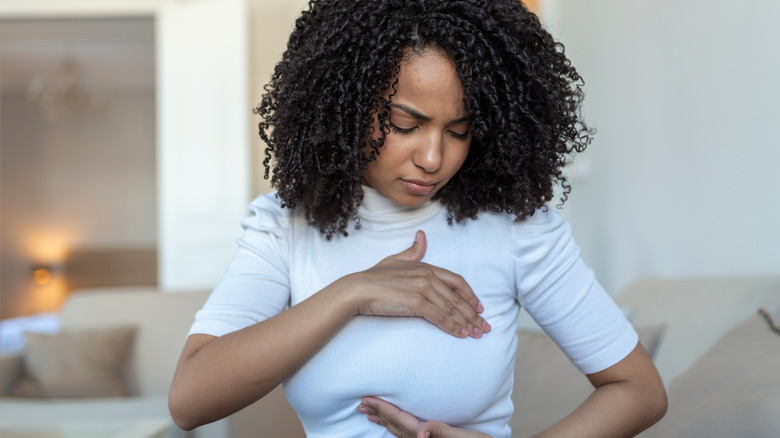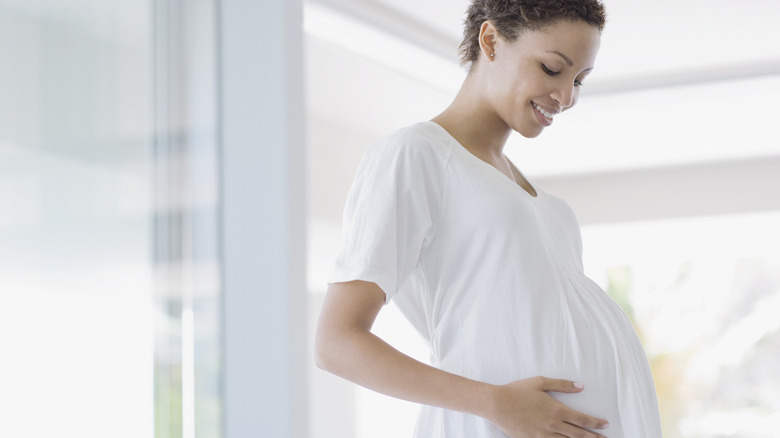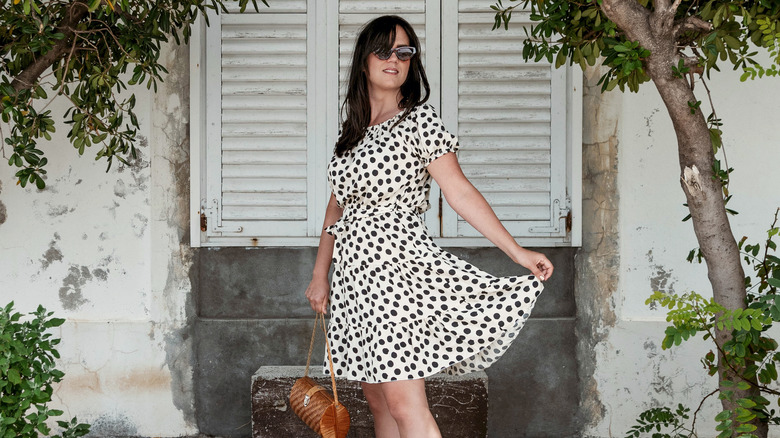Why You Have Bumps Around Your Nipples
Whenever you find a bump on your body, you might find yourself becoming alarmed. Especially when it comes to specific areas of your body, coming across a bump can be confusing. Luckily, many bodily bumps are completely normal, and there are helpful reasons why they exist. Some types of normal, beneficial bumps can even appear on your nipples, according to the National Health Service (NHS). Found around the darker area of the breast, on the skin called the areola, small bumps can form to keep the nipple they surround from becoming dry.
The official name for bumps on a nipple or areola is Montgomery glands or Montgomery's tubercles, reports Healthline. Both women and men can develop these nipple bumps, but they are more common for women. Montgomery's tubercles can provide relief to the nipple by releasing fluid and moisturizing the skin and tissue that would otherwise dry out. A form of sebaceous oil glands, these small bumps also prevent germs from affecting the breasts by producing defensive lubrication. As many as half of all women have noticeable Montgomery glands during pregnancy and usually have between two and 28 bumps at a time. However, having more than 28 Montgomery glands is possible and not a cause for alarm. Here's what you should know about these nipple bumps.
Causes of Montgomery's glands
The majority of the time, Montgomery's tubercles aren't noticeable unless a woman becomes aroused and her nipples are stimulated, or she becomes pregnant (via MedicineNet). While pregnant, a woman may notice the bumps around her nipples grow in size or become swollen as her breasts prepare for impending breastfeeding. It's important to keep in mind that while a change in size and texture of Montgomery glands is often normal during pregnancy, you should seek urgent medical attention if the glands become inflamed, painful, or produce discharge containing blood.
Even though women frequently experience Montgomery's tubercles during pregnancy, being pregnant isn't the only cause of these small nipple bumps (per Healthline). Any time when a woman experiences hormonal changes is a potential reason for Montgomery glands to develop and release fluid to lubricate the nipple and areola tissue. These periods of Montgomery gland-inducing hormonal changes include puberty, during regular menstrual cycles, when menstrual cycles are disrupted or hormonal imbalances occur, and when a woman is experiencing nipple stimulation, along with changes in weight, or a strenuous amount of stress. Clothing that is tight, such as a bra or other apparel, can also provoke the formation and fluid release of Montgomery's tubercles. Nevertheless, there are some medications that carry side effects that influence Montgomery glands, so let your doctor know if you notice new or increased bumps around your nipple after starting a new medication.
Protecting these useful glands
Montgomery's tubercles can help your nipples remain clean and germ-free, especially during and after pregnancy, and help your breastfeeding baby locate your nipple through the scent produced by their emitted oil (per Mother&Baby). In turn, you'll want to prioritize steps to take care of these precious glands that serve many benefits. To keep Montgomery glands free from infection, never squeeze or pop them. Sometimes mistaken for pimples, Montgomery's tubercles can become susceptible to inflammation, soreness, and other unwanted side effects if they become overly irritated. Despite their resemblance to acne, they should never be picked at or squeezed. Similarly, skin products and acne treatments that may be recommended for other parts of your body should never be used on Montgomery tubercles or around the nipples. To properly cleanse areas containing Montgomery glands, use only warm water to rinse and sanitize. Whether you have Montgomery's tubercles or not, avoiding harsh soaps and body washes on and around your nipples is generally the best rule of thumb to follow.
To protect your nipples and any Montgomery glands, avoid tight bras, undergarments, and clothing (via Healthline). In addition to wearing loose-fitting bras and clothing, it's important to maintain hygiene when it comes to your apparel. In fact, wearing a bra for too long after exercising or sweating can create a ripe environment for the growth of bacteria and yeast, which can in turn pose harm to the nipples and breasts (via Cleveland Clinic).



